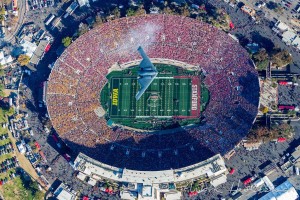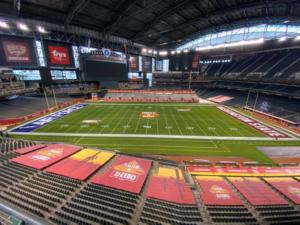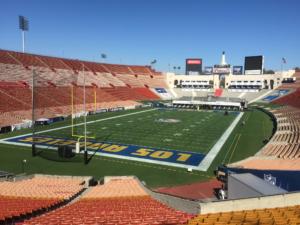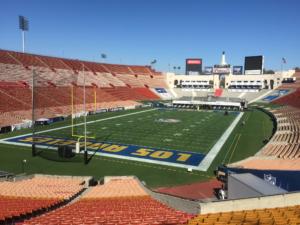Oct
NFL Player Safety: the Role Grass Surfaces Play
Football is a rough contact sport, one with inherent risk for on-field injuries. While those injuries are inevitable, the extent and severity of them depend on several factors. One of those factors that is currently trending in the news is the use of grass versus artificial turf. Aaron Rodgers started and ended his season with the Jets during Week 1 of Monday Night Football with a torn Achilles tendon. So what does this have to do with grass? Well, a lot.
In terms of safety, there is a huge difference between playing on natural grass and artificial turf. Here are a few:
1. Traction – with natural grass, you get more consistent traction as well as footing. Players are less likely to slip on sod than they are on slippery turf.
2. Shock absorption – since grass is much softer and more forgiving of a surface, it provides much better shock absorption, which cuts down on injuries and concussions by absorbing the impact players’ bodies might otherwise take.
3. Lower risk of scrapes to players’ bodies – skidding into any surface can be painful, but natural grass provides a softer landing than artificial turf, as it’s much less abrasive.
4. Joint injuries – since a grass surface is much more forgiving, it causes less stress to joints, such as knees and ankles – both season-ending injuries for an NFL player
5. “Turf burn” – artificial turf reaches much higher temperatures than natural grass. Especially in the beginning of a football season in warmer regions, this can cause heat-related injuries for players, as well as discomfort in general.
Optimizing player safety is a top priority for every NFL team and the surface they play and practice on plays a larger role than most people know! West Coast Turf provides sod for many football fields, among many other sports and venues. For more information, visit our website at: westcoastturf.com
Comments Off on NFL Player Safety: the Role Grass Surfaces PlayMay
WEST COAST TURF: THE OFFICIAL SOD SUPPLIER OF THE ROSE BOWL STADIUM
After more than three decades of supplying natural grass to sports facilities, landscapers, golf courses, cities, parks, and homeowners, West Coast Turf has become the Official Sod Supplier of the Rose Bowl Stadium.
“Our first job at the Rose Bowl was providing some sod for Super Bowl XVII over 30 years ago,” said West Coast Turf’s marketing director, Danielle Scardino. “After establishing a relationship and trust with the outcome of that job, we haven’t looked back. Our company has been involved in every Rose Bowl Game® and has provided almost every field at the stadium since. We’ve worked closely with the Turf Superintendent to ensure they are getting exactly what they want and expect on the field—they are very ‘hands on.’ The result has been pretty much perfection.”
The Rose Bowl Stadium is sodded with grass grown in the Coachella Valley near West Coast Turf’s Palm Desert, CA, headquarters.
“The Rose Bowl field is an iconic American sports field, and one of the greatest sports venues in the world. We are honored to become official partners,” said Scardino.
About West Coast Turf
West Coast Turf is a full-service sod company providing natural grass, field resurfacing, stolonization and hydroseeding services. Their main office is in Palm Desert, CA, and have additional offices in Scottsdale, AZ; Livingston, CA; Patterson, CA; Winchester, CA; and San Marcos, CA. West Coast Turf grows more than 30 varieties of grass and is the West’s largest grower of drought tolerant warm season turfgrasses.
Other clients include:
- Los Angeles Dodgers, Los Angeles Angels of Anaheim, Oakland A’s, and San Francisco Giants in Major League Baseball.
- San Francisco 49ers of the National Football League.
- The National Football League for nine Super Bowls.
- The San Jose Earthquakes, LA Galaxy, Austin FC, LAFC and Phoenix Rising FC soccer clubs.
- The Los Angeles Coliseum, Stanford Stadium and Sun Devil Stadium college football fields.
For more information about West Coast Turf, visit www.westcoastturf.com.
To join social media conversation, visit West Coast Turf on Facebook, Instagram, and Twitter @WestCoastTurf.
About the Rose Bowl Stadium
The Rose Bowl Stadium is a National Historic Landmark built in 1922 and known around the world. The Rose Bowl has earned its world-class reputation by hosting five NFL Super Bowl games, the 1984 Olympic Soccer matches, the 1994 Men’s World Cup, the 1999 Women’s World Cup, four BCS National College Football Championship Games and the College Football Playoff Semifinal Game.
The Rose Bowl is the proud home of the annual Rose Bowl Game®, UCLA Bruins Football, world-class concerts, International and Premier League soccer matches, music festivals, community events, AmericaFest 4th of July Celebration, and the World’s Largest Flea Market.
Comments Off on WEST COAST TURF: THE OFFICIAL SOD SUPPLIER OF THE ROSE BOWL STADIUMNov
West Coast Turf Wishes The Rose Bowl Stadium a Happy 100th Birthday
Friday, October 28, 2022 was the Official 100th Birthday of the Rose Bowl Stadium in Pasadena. At West Coast Turf, we are proud to provide them with their sod and we join them in celebrating one hundred years of being one of the most famous and beloved venues in sporting history.
Some fast facts: The Rose Bowl has a seating capacity of 92,542, making it the 16th largest stadium in the world, and the 11th largest in the United States. Best known as a football stadium, it’s been home to the UCLA Bruins football team since 1982 and has hosted 5 Super Bowl games (3rd most of any stadium). It’s also a notable soccer venue, as well as a concert venue for many of the most iconic and famous musicians – Michael Jackson, Pink Floyd, The Rolling Stones, U2, and Journey all played there, as well as Lilith Fair festival.
The Rose Bowl was designated a National Historic Landmark and a California Historic Civil Engineering landmark in 1922. Since 1993, West Coast Turf has been the proud providers of their turf that so many sports and teams have played on. We know that the grass you play on is one important aspect of what makes a stadium so popular, and we are honored to provide their Bermuda sod for them year after year.
To see our full client list, click on the About Us section.
Comments Off on West Coast Turf Wishes The Rose Bowl Stadium a Happy 100th BirthdayDec
CHASE FIELD GETS NATURAL TURFGRASS OVERLAY FOR 2019 CHEEZ-IT BOWL
90,000 sq. ft. of West Coast Turf Bandera Bermuda Sod Put on Top of New Artificial Turf for December 27th Football Game
Phoenix, AZ……The Cheez-It Bowl is ready for the Air Force Falcons vs the Washington State Cougars on December 27th, on a new natural turfgrass field.
Just last week, West Coast Turf installed 90,000 square feet of their 1” thick overseeded Bandera Bermuda sod directly on top of Chase Field’s new artificial turf baseball field. Installation took 2 days, and a layer of polyethylene plastic sheeting was put in between the artificial surface and the natural sod. The sod is thick-cut and weighs approximately 15 lbs. per sq. ft. so that rooting will not be a factor with such a short time frame. The weight will give the sod its stability.
Comments Off on CHASE FIELD GETS NATURAL TURFGRASS OVERLAY FOR 2019 CHEEZ-IT BOWLJan
College Football Fever
It was a busy College Football Bowl season at West Coast Turf!
We started off by grassing Chase Field in Phoenix, AZ, on December 19th for the December 26th Cheez-It Bowl, in which the TCU Frogs beat the Cal Bears in overtime.
The San Diego County Credit Union Holiday Bowl was played on West Coast Turf at the SDCCU Stadium (formerly Qualcomm Stadium) on December 31st . Northwestern Wildcats topped the Utah Utes.
The Redbox Bowl was also played on New Years Eve at Levi’s Stadium in Santa Clara, CA. The Oregon Ducks defeated the Michigan State Spartans by a single point.
The “Granddaddy of Them All,” the Rose Bowl game, was played in Pasadena on New Years Day. Rose Bowl groundskeeper, Will Schnell, said was “the best field I have ever had.” Schnell added that the day after the game the field looked as if it hadn’t even been played on. Wow.
But the field absolutely was played on. The Ohio State Buckeyes outperformed the University of Washington Huskies in Urban Meyers’ last appearance as head coach of Ohio State, and his first time at the Rose Bowl. The social media world described the turfgrass at the Rose Bowl as “a green cloud,” “the greatest patch of turf in America, capable of causing grown men weep at its green grass,” “…..there is no greener grass in America than the grass in the Rose Bowl–one of the most beautiful sights in sports,” “the Rose Bowl grass is the definition of perfect.” Shall we go on?
But it doesn’t end there.
West Coast Turf was up to an unusual challenge up at Levi’s Stadium this year. During the New Years Eve Redbox Bowl, West Coast Turf crews were hard at work harvesting a new field at their Livingston, CA, farm. It was be installed at the stadium for the College Football Playoff National Championship game to be played just a week later on January 7th between the Alabama Crimson Tide, and Clemson Tigers. But first, the Redbox Bowl game needed to be completed, and the field removed. Our turf removal crew was on standby in Santa Clara and began the removal procedure about 5:30 pm, finishing the process at 1 am. Crews worked through the night in shifts installing the new field (22 truckloads worth!) and completing the entire process in 24 hours.
The sod for the National Championship game is a specialty product that was grown on plastic out at the West Coast Turf farm. It is thick-cut, and without time to root, it is heavy enough that the natural turfgrass will remain in place. The Levi’s Stadium staff was very pleased with the process, and amazed it went so quickly and seamlessly!
After the field was installed, the tailgate areas and some of the streets around Levi’s Stadium were sodded for fan enjoyment.
West Coast Turf is your leader in Arizona & California Sod.
Comments Off on College Football FeverDec
Cooler Turf for Hotter Climates
In hot desert climates, many people look for ways to find water-saving methods with their lawns and sporting fields. One seemingly wise remedy that is by using artificial turf. On its face, this seems like a good solution. However, there are several major reasons why natural turf is still king.
Chief among these reasons is the temperatures artificial turf can reach in hot weather. In warmer months, artificial turf can reach 200º – no, that’s not a typo. That temperature is so much higher than the 122º that’s considered safe for use by professional athletes, much less your family and pets. This temperature of turf is such that you couldn’t put your bare feet or hands on it for longer than a few seconds before it would burn you. This means that during summer months, artificial turf simply is not suitable for play during daytime hours. So one might ask, are its water-saving benefits worth the cost of installation if it is unusable during the daytime for several months out of the year. One way to cool down the artificial turf, users say, is to hose it down and it is suggested to do so every thirty minutes in order for it to stay cool enough to safely play on. However, this practice when used on turf installed specifically to conserve water, defeats its own purpose (while creating humidity in the attempt to cool the artificial turf down).
In addition, using artificial turf has other consequences, some unintended. One is a phenomenon called the urban heat island effect. This means that the artificial turf, similar to concrete and asphalt, actually radiates heat back into the night air, causing warmer nights for the areas that have it and causing nearby plants and grass to need extra water.
At West Coast Turf, we are experts in natural grass, specifically Arizona sod (and you Arizonans know better than anyone how hot the summer months can be!) and have provided the natural turf for many professional fields, including MLB, NFL, professional training fields, college football and baseball fields, racetracks, Major League Soccer, and more. Contact us to find out more about why we’re the best in our field and what we can do for you!
https://www.westcoastturf.com/
Comments Off on Cooler Turf for Hotter ClimatesOct
NFL Turf
In the NFL, the football fields players practice and play on have either natural grass or artificial turf. More than half of the fields boast natural grass, but there has long been a debate over which surface is better. Many aspects factor into this: injuries, cost, and personal preference.
On artificial turf, studies have shown that injuries are more prevalent than on natural grass. A 2012 study showed that more college football players suffered ACL injuries on turf than on grass. John Brenkus, creator of Sport Science videos, said that turf increases stress on the ACL joint by about 45% and talked about a study covering over 2,600 NFL games, saying players were 67% more likely to sprain their ACL on turf than on grass. As we all know, an ACL injury can mean the end of a player’s season.
Turf typically comes with a hefty price tag. Many explore the benefits of natural grass and its cost to maintain/replace worn areas throughout the year. Preserving the natural grass playing surface would results in cost saving. Many coaches and training staff prefer natural grass, whenever possible. Said Casey Carrick, the director of athletic grounds and turf management at the University of North Carolina, “Natural grass was the preferred surface by players, coaches, us, and trainers and it was the cheaper option. By the end of the season, we had only used half of the amount of sod we had budgeted for, a significant savings versus going synthetic.”
West Coast Turf are specialists in natural grass, particularly Arizona sod. With such clients as the former Candlestick Park, San Francisco, CA-Old Home of the San Francisco 49ers, Levi’s Stadium, Santa Clara, CA-NEW Home of the San Francisco 49ers, and Oakland Coliseum, Oakland, CA-Home of the Oakland Raiders, the los Angeles Coliseum—current home of the LA Rams, and STUBHUB Center—current home to the Los Angeles Chargers, as well as 8 Super Bowl fields. We are the experts in natural grass fields for all of our sports clients, from college football to the NFL.
Visit us online to learn more: https://www.westcoastturf.com/
Comments Off on NFL TurfSep
Pre-Overseeding Tips for Your Lawn
I would like to start by congratulating everyone on making through another California and Arizona summer. I know we still have a couple months of triple digit temperatures, but the worst should be behind us at this point. As we move into September our morning temperatures will start to feel less painful, but remember your warm season grass is loving this weather–especially your California and Arizona sod. I have started to field questions regarding fall overseeding and I want to tell you to hit the brakes. Don’t just tap the brakes, slam on the brakes. You will see ryegrass hit the stores in the next week but walk away or buy it and sit on it until temperatures really drop. Today I want to discuss prep for the fall, and how to get your grass ready to overseed. This won’t be a tutorial on how to overseed, but instead some pointers of what to do before you overseed.
Comments Off on Pre-Overseeding Tips for Your LawnApr
Keep your Athletic Field Running All Year Long with Arizona Sod

Players may be ready to hit the field, but before they do the field must be ready for the players first. Since different sport’s seasons run all year long, and many fields have a multi-sport purpose, keeping your athletic field in the best condition for players and fans alike may be easier said than done.
Is your athletic field ready for the sport’s seasons to come? To answer that question, you must first understand the main components that make up a well-built field. The three main components of a well-built athletic field are: safety, playability and aesthetics. To accomplish these three components, there is only one factor to keep in mind.
Comments Off on Keep your Athletic Field Running All Year Long with Arizona SodSep
OVERSEEDING TIME FOR YOUR LAWN! (Well….almost!)
We are quickly approaching the best time to overseed your lawn, but I also know that many people don’t have a choice and need to get their lawn done sooner than later. This can present a few potential problems, but I will give you a few ways to help you get healthy turf if you need to drop seed this weekend. The best time to seed is when night time temperatures dip into the high 60’s, and we start to cool off a little bit during the day. It is always nice to be out of the 100’s before beginning the overseed process, but it’s okay to start prepping now in order to get ready for the season. A couple weeks ago I gave you the easy 1,2,3 fertilizer and seed steps, and today I want to talk a little more about what needs to be done with the prep work.
Comments Off on OVERSEEDING TIME FOR YOUR LAWN! (Well….almost!)



